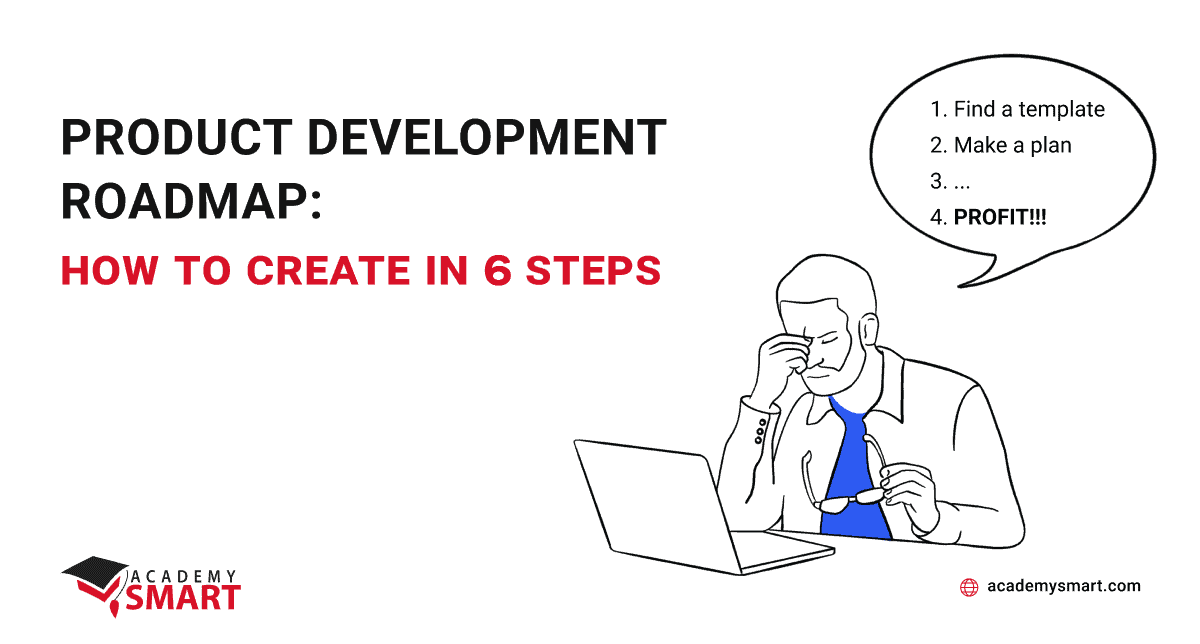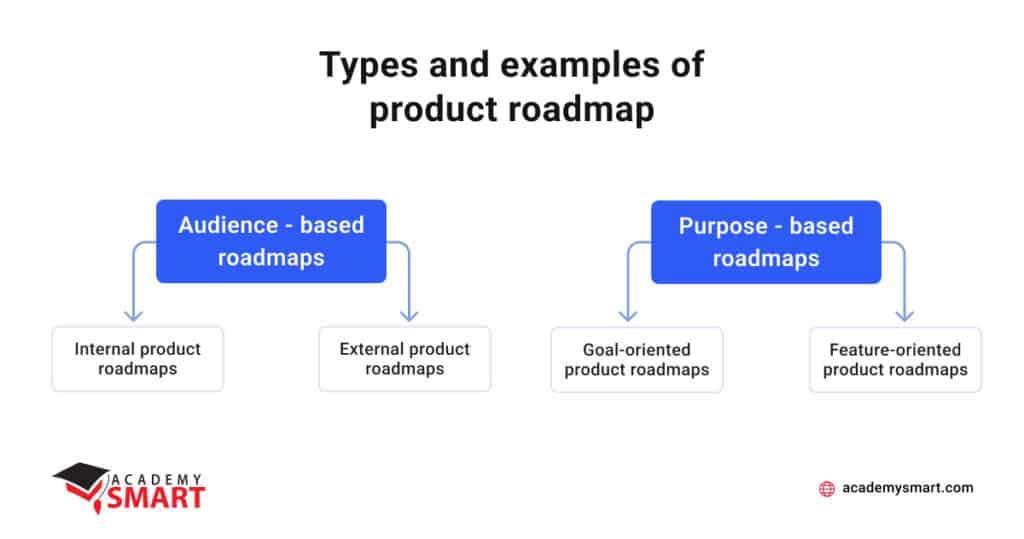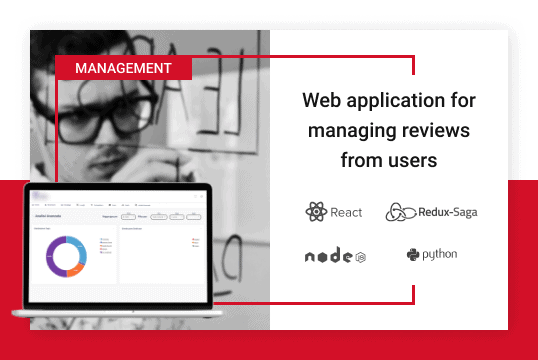
Product Development Roadmap: how to create in 6 steps
Contents
It’s well known that thorough planning is the best guarantee of an idea’s implementation in a quality manner. To create such complex products as information systems and software, planning the final result should be as flexible and precise as possible.
A particular organizational tool known as a product roadmap aids software development teams in visualizing the goals and the order in which they are achieved. Due to its flexible settings, project managers can solve many tasks by coordinating the efforts of IT specialists and their clients and monitoring the progress of software development, making timely corrections according to the current situation on the market.
This article will tell you what a product roadmap is, who makes it, and why. We will also consider the main varieties of product roadmaps and the optimal algorithm for their creation.
What is a product roadmap strategy
So, a product roadmap is a document that indicates the overall goals that face developers and the executive strategy for achieving them. What is the basis of this document?
To begin with, the customer comes to the developers with some idea for a new software product. Usually, it is a general view of its value for future users, what functions it can perform, and how it will occupy its market niche. Such an idea pool is called a product vision.
The main task of the development team at the stage of getting acquainted with the customer’s product vision is to perform a detailed analysis of internal and external stakeholders’ needs and take into account product requirements imposed by the current state of the market, competitors’ experience, and technology stacks. The strategy of any product roadmap is formed based on the results of this analysis by the project manager and a list of feature ideas that forms the product backlog. It demonstrates the sequence of actions that create the future value of the product in specific software releases.

The path from product vision to specific tasks
Depending on who the roadmap is addressed to, it may have a general strategic nature with a focus on thematic sections of new product development to demonstrate the project’s current state to the customer. Or conversely, it may contain a higher level of detail, metrics, and other technical information that is important for coordinating specific implementers and their departments. Regardless of the particular type, however, any product development map must meet the following requirements:
- to reflect the product creation and development strategy;
- to articulate goals and their priorities accurately, linking them to the customer’s business objectives;
- to establish long-term timeframes;
- to have unambiguous status markers;
- to act as an effective communication tool within or outside the development team;
- to be dynamic and evolve with the product and market state.
As you may have noticed, a roadmap for product development is a strategic-level document that usually reflects a general idea of project development shared by the project manager and stakeholders in its dynamics.
It is essential to understand that the roadmap differs from the direct project work plan, developed within the outsourced team, detailing the tasks and defining the order of their implementation at the tactical level. For more details on how remote development teams work, see the article Outsourcing vs Outstaffing: What To Choose. Also, a roadmap is not a release plan since it contains a general forecast of project development rather than a list of release dates for specific software product features. And since this is the case, there may be doubts about whether developing a product roadmap is worth the time and effort to create it. Let’s define who needs this tool and for what purpose.
Who owns the product roadmap
Throughout our narrative, we have mentioned more than once the project manager. Now is the correct time to clarify that a project manager (or PM) is a representative of the development team responsible for organizing software engineering workflow and delivery of the final product. Developing a product roadmap PM coordinates its variables with the client and stakeholders (the client’s partners, development company owners, marketing and sales departments, etc.) You can find a detailed description of the project manager’s duties in the article Project Manager role in Outsourcing companies, and here we’ll concentrate on one, probably the most important of all.
Since PM is a moderator of communication between the customer and the developers, he accumulates their expectations and proposals, bringing them to the addressee and thus ensuring mutual understanding of the parties. By exploring the customer’s vision of the product, current market trends, and the contents of project backlogs, PMs form a holistic view of value creation dynamics, which is aligned with the customer side. Performing the conditional role of product owner (PO) in the language of scrum methodology, the project manager seeks to achieve a common understanding of the product and its place in the market and to complement the customer’s value proposition with that of his team, which he relays to the actual software owner.
The product roadmap is a documented fixation of the compromise decision of the parties regarding the method and approximate timeframe for achieving the customer’s objectives. Of course, the PM, who owns the product roadmap, is interested in making a specific and clear strategic program, preventing many of the risks associated with misunderstandings between the parties.
Despite its predictive nature, the roadmap is a good demonstration of the current stage of the project and a guide for the future, forming a unified vision of the product development direction and synchronizing the efforts of all the participants involved. On the other hand, it eliminates outside interference in previously agreed low-level development processes, regulating the consideration of emerging issues at the level of project management and above.
Types and examples of product roadmaps
As we mentioned earlier, depending on the concrete coordination tasks, PMs can create different roadmaps for new product development, highlighting those or other significant aspects of the project. Equally, there is a wide variety of target templates offered by software services that specialize in creating product roadmaps, such as ProductPlan, OpenProject, Roadmunk, or Roadmap Planner, and even Microsoft Excel.
Of course, identifying specific types of product roadmaps is mainly arbitrary, and discussions are possible regarding the basis for classification. Here we focus only on the most common ones and note their essential features.

Common product roadmap classification
Audience-based roadmaps
As practice shows, different audiences require different roadmaps. In many ways, the expectations of the audience determine the shape of the map, its content, and detail. For this reason, they are usually divided into maps for external and internal use.
Example: Internal product roadmaps
The maps that PMs make for use within the development company are designed to coordinate the various departments involved in product development. They are usually addressed to the company’s management, development, marketing, and sales executives.
Of course, depending on which particular division the information in the roadmap is intended for, the presentation and level of detail varies. And this is natural because the company management is interested in a strategic cross-section of the work on the product as a whole, the sales department is rather focused on the value of the product through the prism of its functions, and the development department – is on the technical details of the tasks set implementation.
In principle, the option of making a common strategic roadmap of product development for all users at once is not excluded, but it is only sometimes justified because of the unwieldiness of presenting multi-level information.
Internal roadmapping can be done in any form, be it event calendars, mind maps, feature lists, kanban boards, tables, charts, graphs, etc., according to accepted standards in the company.

Example of internal product roadmap
Example: External product roadmaps
External roadmaps are addressed to the clients, their partners, and any other public outside the development team. An example of such an audience could be departments of a client’s company that are not directly involved in creating a new product but for which it is essential to compare the dynamics of all products in the aggregate to make the necessary management decisions.
The main task of the external product roadmap is to demonstrate the benefits of the chosen strategic solutions and the generalized sequence of steps to be taken. The internal development processes are not reflected in such maps, and the timeline is approximated.
As a rule, project managers prefer a presentation format for such product roadmaps, making the most of their visibility and concentrated informativeness.

Example of external product roadmap
Purpose-based roadmaps
Another example of the conventional division of product roadmaps is structuring them around common goals or specific functions.
Example: Goal-oriented product roadmaps
By starting from the specific goals that the product to be developed should put into practice, the PM can group information logically and visibly at the highest strategic level. It happens because a clearly defined goal such as “simplify registration,” “increase engagement,” or “provide feedback” by default implies the need to select particular features to achieve it. In this case, it is easy to formulate and combine goals thematically, setting priorities and thus building the structure of the software product and the overall strategy of working on the project.

Example of goal-oriented product roadmap
Example: Feature-oriented product roadmaps
The opposite approach places the intended functions of the product in the focus of the roadmap, filling it with detailed and concrete content, although sometimes unjustifiably cumbersome. Indeed, focusing on particular product features in a certain way complicates the perception of the product as a whole. As a consequence, it is objectively more difficult to make the transition to a higher level of representation in such a map.
An additional difficulty of operating with that type of roadmaps is created by the variability of the feature status, as such. New trends in the market, changing user needs, and technological improvements inevitably lead to systematic changes in the set of features in use. Due to the specific nature of feature-oriented product roadmaps, they are intended more for internal use by the development department. However, they can be presented to an external audience as a preliminary release plan for certain product versions.

Example of feature-oriented product roadmap
Of course, it isn’t an exhaustive list of the possible types of product roadmaps you may encounter in practice. As a rule, they are lower-level documents in which the development strategy of particular product elements is considered. So, for example, technology product maps describe how to use technology stacks, which allow you to allocate the information and labor resources associated with it. Or platform roadmaps, which plan the release of product versions for certain devices.
It’s clear that there is no single standard for this type of documentation, and product roadmaps can vary significantly among developers from project to project. Below you may watch the projects that Academy Smart was involved in developing. As you may have guessed, each of them started with a detailed product roadmap drawn by our PMs.
How to build a product roadmap: 6 steps
So now we are almost ready to find out how to make a product roadmap successfully. First of all, let’s note that for the engineering of a software product, in most cases, developers use one of two popular methodologies:
- Waterfall.It is based on a simple sequence of stages of software creation: idea – design – development – testing – launch. In this case, there is no return to the previous steps.This methodology leads to a straightforward structure of a long-term roadmap with a clear budget and deadlines for each stage. On the other hand, the development by cascade methodology is not malleable, and in the case of force-majeure circumstances, may lead to a possible deterioration of the product quality or its appreciation.
- Agile.It is based on the breakdown of the overall process into cycles of development, which replace each other, thereby eliminating the defects of the previous ones: idea 1 – design 1 – development 1 – testing 1 – launch 1 – analysis 1 – idea 2 – etc.Agile allows for building a flexible product roadmap focusing on short- or medium-term planning of the development process to get a high level of adaptability, and reallocation of budget and labor resources.Working with this methodology is objectively more complicated and requires a high level of professionalism from the project manager and executors to react to changes in plans in time. On the other hand, this model is client-centric and allows the use of resources flexibly and efficiently.

Waterfall and Agile models in comparison
In practice, different development teams prefer one or another model depending on the nature of the project, although western companies prefer Agile. In our article How to Hire an Offshore Development Team, you can learn more about how offshore software developers from different countries work and how to find the right team.
In addition to a suitable planning methodology to create a product roadmap, PM needs a good data visualization tool. In principle, you can use the standard tools of Microsoft Office or its analogs for this purpose. But they can hardly compete with professional project management services, which are equipped with powerful visualization features, various product roadmap templates for different planning types, and easy sharing of ready maps. Currently, free, open-source tools (OpenProject or Roadmap Planner) and paid tools for every taste (ProductPlan, Aha!, Roadmunk, Craft.io, Hygger, and others) are available.
1. Define your target audience
Recall that the content of a product roadmap depends directly on who it is intended for. Management expects you to have a holistic strategy, Sales need competitive advantages, and a timeline for their implementation, and the development department waits for timeframes for thematic sprints. Think about what information the recipient expects from you and discard anything unnecessary.
2. Choose the right roadmap structure
Decide how you will build your product roadmap. Do you need a strict timeline, or is precise long-term planning impossible in the case of this project? How should you organize information if you can clearly articulate immediate short-term objectives only?
3. Formulate key goals and objectives
Remember that you are engaged in strategic planning. So formulate only the key goals and objectives without going into unnecessary details. At this stage, you should refrain from the temptation to turn the creation of a roadmap into an actual development plan and keep the focus only on the essentials.
4. Gather and organize product requirements
Gather all the ideas and expectations for the product you have received from all stakeholders. Analyze the wishes of the customer and its partners. Take into account the objections and suggestions of engineers, marketers, and sales specialists. Find out the market situation, the strengths, and the weaknesses of the competing products. Be sure to clarify the customer’s and your team’s vision regarding those product parameters for which there is a risk of misunderstanding, and agree on a common position.
5. Define your development strategy
Generate an incoming backlog. Organize all inbound information thematically, and prioritize the tasks that flow from it. Determine which tasks your team has to start working on immediately. Mark the workflows that can be run in parallel and at what stage. Present this information understandably.
6. Provide ways to track and manage workflows
When creating a product roadmap, you should stipulate how you will monitor the implementation of the strategy, evaluate its effectiveness, and make ongoing changes. Keep your recipients in mind; they should also be notified of adjustments to your plans on time.

Web App to manage users reviews, updated by Academy Smart
Finally, here are some tips to make your product roadmap better:
- use product roadmap templates and create your own;
- focus on the essentials and avoid excessive detail;
- strive for clear language;
- keep realistic goals and deadlines;
- limit access to the roadmap to the target audience only and establish communication within to capture and respond to changes promptly;
- regularly check the status of the processes in the map and analyze them.
After reading this article, you may reasonably decide that managing the software development process is better left to professionals. Yes, effective organization of a developer’s workflow requires special skills and attitude. The Academy Smart team does it with pleasure and will be glad to help you turn your ideas into reality.
Product Development Roadmap: Frequently Asked Questions
What is product roadmap software?
The product roadmap is a visualization of the software creation strategy, the stages of its development and promotion.
Benefits of product roadmaps
The main advantages of product roadmaps are:
- unity of strategic vision;
- visual presentation of the project objectives and its scope;
- clear priorities and deadlines for tasks;
- dynamism and feedback.
Planning software development, then let’s make your product roadmap together.
Book a free consultation

Reach out to start talking today!











